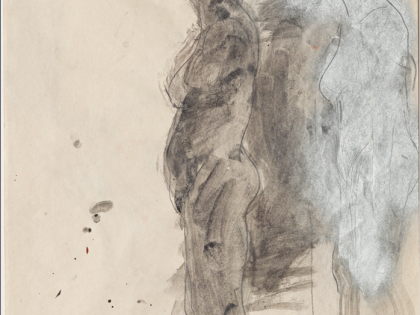Manuel Neri
Makida III 1997

Reproduction of this image, including downloading, is prohibited.
Makida III, a carving of [Makiko] Nakamura’s head in veined Carrara marble, suggests a synthesis of Eastern and Western artistic traditions. Its larger-than-life scale and placid expression evoke the contemplative mood of temple statuary found in the Eastern tradition. The polished stone is partially masked with gestural strokes of bright pink-and-green paint used to set off her traditional Japanese hairstyle. When the figure is viewed from behind, the undulating shapes and energetic brushstrokes of her hair seem to morph into abstraction.
In the late 1970s Neri began making regular trips to Carrara, Italy. He established a studio there in 1981 in order to readily access marble from the city’s famed quarries. Neri’s practice was profoundly affected by his proximity to the sculptural traditions of Western civilization, from the art of ancient Etruscans and classical antiquity to the haunting figures of Italian modernists Alberto Giacometti and Marino Marini. In Carrara Neri also met the artist Makiko Nakamura, who would inspire a rich series of work. Nakamura posed for Neri wearing traditional Japanese clothing and hairstyles. As in his works modeled after Joan Brown and Mary Julia Klimenko, Neri’s Makiko series emphasizes his interest in the anonymity of the body as form, as opposed to the individuality of portraiture, though here the body is imbued with an unmistakable Eastern exoticism. The drawings from the Japanese Dancer series, for example, emphasize a generalized sense of movement, suppleness, and coded cultural symbolism.
-Sidney Simon, PhD’18





![Japanese Dancer Series No. 12 [Makiko], 1980](https://anderson.stanford.edu/wp-content/uploads/2017/07/MN.1980.DWG_.045-220x311.jpg)
![Japanese Dancer Series No. 2 [Makiko], 1980](https://anderson.stanford.edu/wp-content/uploads/2017/07/TAC-58666-220x311.jpg)
